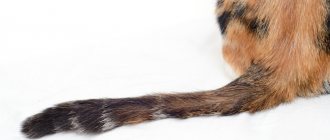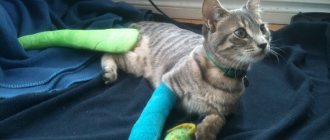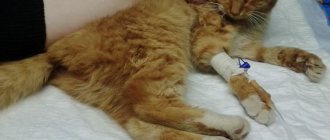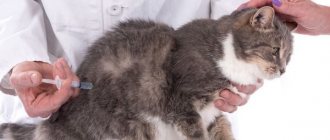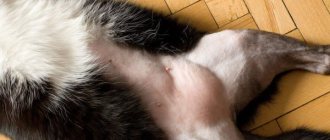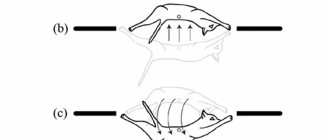Treatment of fractures in cats is one of the main surgical areas in veterinary medicine.
A fracture is a complete or partial disruption of the integrity of a bone, which occurs due to an external mechanical force that exceeds its strength. Fractures in cats can be classified into two groups: traumatic and pathological. Traumatic fractures occur due to mechanical impact, in cats most often as a result of a fall from a height or auto injuries, as well as bites by dogs. Occasionally, we also receive cats with gunshot fractures.
Pathological fractures in cats occur even with a small impact, as they say, “out of the blue.” They occur when the bone becomes more fragile as a result of some pathological process - usually this is how bone tumors or metabolic disorders associated with poor nutrition affect the bone tissue. In cats, such problems are usually associated with so-called secondary nutritional hyperparathyroidism. Under this terrible name lies a banal reason - with an excessive meat diet, too much phosphorus and very little calcium are supplied with food. As a result, calcium for the body's functioning - maintaining muscle and heart function - is washed out of the bones under the influence of parathyroid hormone. Bones become very fragile and break “out of nowhere.”
Doctors divide fractures in cats into closed (the integrity of the skin or mucous membrane is preserved) and open (the skin or mucous membrane, for example, in the oral cavity, is broken by a bone fragment); into simple (the bone breaks into only two parts) and complex (comminuted fractures); into transverse, oblique and helical – according to the shape of the fracture; intra-articular fractures (those that occurred in the intra-articular cavity) are also distinguished.
What symptoms may indicate that a cat has a fracture?
If a cat has a broken paw (front or back) - and veterinarians have to treat such fractures most often, you will see the following signs of a fracture:
- the animal does not lean on the affected limb at all
- the cat is taking care of its sore paw, an attempt to touch it results in a flash of pain, your pet may try to bite you
- severe swelling of the soft tissue appears at the site of the fracture - the diseased paw is twice as thick as a healthy one, a large hematoma may appear
- the configuration of the diseased paw is changed, it seems asymmetrical in relation to the healthy one
- a bone fragment can be seen through the skin
With specific fractures in cats, you can notice other external signs - for example, if the cat has a broken jaw, it cannot eat, trying to open its mouth causes pain, the muzzle may lose symmetry. If a cat has a fracture of the spine or pelvis, she cannot rest on her hind legs, they drag, and control over bowel movements and urine output is often lost.
Prevention measures
The largest number of fractures are caused by injury, so it is better to limit the time the cat spends in the fresh air. This will minimize the risk of damage from cars and eliminate the possibility of encountering other animals.
It’s worth paying attention to your pet’s behavior and habits when he comes back from a walk.
The most common injury among domestic cats is a broken paw, most often the hind paw. Fluffy pets often go for walks unattended, sleep under cars, walk on window sills or climb tall trees. All of the above can cause a fracture.
All owners love their animals and become confused and scared, not knowing what to do in a given situation. The main thing is to gather your thoughts and, in case of such injuries, urgently call a specialist. The veterinarian will provide first aid and save the pet.
What can you do yourself to help your cat?
The main task of first aid for a fracture in a cat is to understand whether there is bleeding and stop it. As a rule, severe bleeding accompanies open fractures, fractures caused by bites and gunshot fractures. To stop bleeding, it is better to use a pressure bandage, which is effective in 90% of cases. We recommend a pack of sterile gauze pads to stop bleeding. If they are not nearby, then you can use a handkerchief, mitten, piece of fabric, or feminine pad. Sterility is not so important now, the main thing is to stop the bleeding, which is life-threatening for the cat. A swab made of napkins or other fabric should be placed directly over the source of bleeding and bandaged quite tightly - with gauze or an elastic bandage, or a piece of fabric. Now - hurry up to the veterinary clinic. Our doctors recommend not wasting time calling a doctor to your home in such a situation, because full care for a fracture can only be provided to a cat in a clinic setting.
If there is no bleeding, but you see that the cat most likely has a broken front or back leg and it is “dangling around a lot,” you can immobilize it in the position it is in. Don’t try to “set” the fracture yourself! This is very painful. If handled improperly, the sharp edges of the bone can damage blood vessels and nerves, causing pain and additional injury to the cat. You just need to ensure that the cat's paw remains motionless while transporting the animal to the clinic. If you are in doubt or afraid, it is better not to do anything and take your cat to a veterinary clinic as quickly as possible.
Diagnostics in a veterinary clinic
The fact that the pet has been injured is immediately obvious, but a visit to the veterinary clinic is still necessary. After examining your pet and conducting a series of diagnostic tests, the veterinarian will determine the extent of the damage and prescribe appropriate treatment.
Necessary diagnostic methods include general and biochemical blood tests, x-rays in two projections, and cardiac echocardiography. In some cases, an abdominal ultrasound is required.
How will the doctor act?
First, the doctor will numb your animal. He then examines the cat and its broken leg. This is of particular importance for those patients who were injured by a car or fell from a height, because in addition to the problems that are obvious to the owner - a fracture - the cat may have a chest or abdominal injury. These injuries to a cat may not be noticeable, but require significantly more urgent and complex treatment than a fracture. After the examination, your veterinarian will take an X-ray of your cat's broken leg to evaluate the fracture and plan treatment, as well as further diagnose other injuries, if any. Sometimes sedation is required for x-rays.
As a rule, 99% of fractures of the front and hind legs in cats require treatment with surgery - osteosynthesis. This operation is performed as planned, often 3-5 days after the fracture. This period is explained by the physiological characteristics of the body: during an injury, massive hemorrhage occurs in the area of the fracture, and then this blood and parts of the destroyed tissue that fall into it become so-called “osteogenic elements” - substances that stimulate the bone to heal. If surgery is performed immediately after a fracture, the entire contents of the hematoma will spill out, and healing will be slower and more difficult. Another difficulty for manipulating bone fragments is created by swelling of the soft tissues, which subsides precisely by 3-5 days after the fracture. The exception is open fractures - due to the open gate for infection, they require urgent (within 24 hours) surgery.
Before surgery, the doctor will fix the broken paw with a bandage.
Of course, fractures of the jaw, pelvis, and spine require a special approach in cats—we’ll talk about them a little later.
How to recognize a fracture or bruise of a hind paw
Examination of the hind paw.
The wound may be between the joints or on the inner surface of the pad, between the cat's toes. It happens that during a jump the animal pushes off the surface incorrectly. In this case, joint dislocation and ligament sprain are almost always guaranteed. Cats who are obese and lead a sedentary lifestyle are most susceptible to such damage.
Fracture of the hind leg of a cat on ultrasound.
The joints of such animals are poorly developed and with a strong push or sudden movement the risk of injury increases. A dislocation, sprain, or bruise may have slight swelling and be quite painful when pressed.
What to do if your cat is limping on its hind leg without visible damage
Severe swelling of the paw.
Upon closer examination, swelling becomes visible, the paw is hot and painful. A significant reason is pathology in the formation of the joint. When the kitten is still small, the symptom of lameness is rarely observed. The baby's weight is insignificant, which means the load on the paws is also small. As people get older, lameness becomes more noticeable.
Lameness in a cat
Another reason for lameness in a cat is due to diseases such as arthritis or arthrosis. Arthritis appears as the animal gets older. The influence on the body of external factors that provoke infectious diseases worsens with age, which makes it possible for inflammatory processes in the joints to manifest themselves.
The older the cat, the greater the likelihood of exacerbations of the disease, which is accompanied by periodic pain and, as a result, lameness.
Arthrosis
The cat is limping on its hind leg due to arthrosis.
It can proceed hidden for a long time, since degenerative changes in tissues, bones and cartilage occur gradually. There are many reasons, the most common is a congenital anomaly of the anatomical structure.
As with arthritis, adult felines are most susceptible, but there are exceptions when the congenital changes are too extensive. Then lameness is observed in young animals.
Traumatic arthrosis
Complex case.
Arthrosis can be traumatic. The cat was injured while walking; there were no obvious symptoms; over time, the bruised tissues, bones, and cartilages begin to rebuild incorrectly. Do not discount lumbar back injuries.
The pet could have been hit during a walk, or it could have landed poorly during a fight with other animals, dogs, for example. With a traumatic injury to the back, nerve endings may be pinched, which causes discomfort when walking.
Why is osteosynthesis necessary when you can simply apply a cast?
Plaster casting is not used to treat fractures in cats for many reasons. To begin with, it is very difficult, even impossible, to force a cat to take care of a broken paw with a cast. And, even more so, provide the animal with bed rest or hang its leg in traction. Cats try to get rid of the cast as quickly as possible, bite it, gnaw it, try to remove it on furniture, causing additional harm to themselves. The second reason is that since cats and dogs almost never break their legs by “slipping on ice” or “unsuccessfully jumping,” they almost never have fractures of the “crack” type or simple fractures without displacement. For this reason, fractures in cats often require complex reduction of fragments and comparison of fragments. Finally, a number of studies have shown that for the fastest and most complete healing of a fracture, several factors are required - the most complete comparison of fragments, their most rigid fixation, preservation of blood supply and early support on the limb. All these requirements cannot be met if fractures of paws in cats are treated with the application of plaster, therefore, throughout the world, osteosynthesis is preferred in both veterinary and human orthopedics, in which recovery occurs faster and with better quality.
Conservative method
Non-surgical therapy begins with an anesthetic. Afterwards, if necessary, the dislocation is reduced and a splint, a plaster cast, and a collar are applied to fix the damaged paw. Much depends on the cat’s behavior, since with aggressive behavior it will not be possible to complete the required steps properly.
Subsequent steps include prescribing medications to the animal to help restore bone tissue and relieve inflammation.
Note! The newest hospitals use effective physical therapy, which allows you to count on a speedy recovery and improved health.
What operations are there?
Osteosynthesis is performed using metal structures with which parts of the bone are fixed to each other. Metal parts can be placed inside the bone (pins, wires), pass through the bone (screws, screws, wire sutures) or attached to its surface (plates). In addition, there are methods for fixing fractures in which the wires pass through the bone fragments, and the main structure that ensures the strength of their connection is located outside the limb (Ilizarov apparatus and other external fixators).
Osteosynthesis is performed under general anesthesia. The doctor selects a fixation structure depending on the type of fracture and accompanying soft tissue injuries. In veterinary medicine, we specialize in complex fractures (comminuted, crushed, multifocal, gunshot). We have all the necessary equipment and experience to treat them, including using external fixators and the Ilizarov apparatus. Many cats, who in other clinics were offered amputation of their paws due to complex fractures, retained their limbs thanks to the joint efforts of our doctors and their owners.
How is the postoperative period going?
As a rule, after osteosynthesis, the cat remains in the hospital for 6 hours to 24 hours under the supervision of doctors. Then, suture treatment and painkillers are usually prescribed for 3-5 days. We recommend restricting movement for 4-6 weeks (cats can be placed in a large cage). The cat usually begins to lean on its paw 3-5 days after surgery.
After 3-4 weeks, you will need to visit the veterinary clinic with your cat again to take a control x-ray to assess the speed of fusion. On average, the rate of fusion, depending on the complexity of the fracture, varies from 2 to 8 months. After fusion, with the exception of rare cases (intra-articular fractures, fractures of the pelvic bones, very complex fractures in which the fixing elements firmly grow into the general mass of callus), metal structures are removed.
How to transport a cat to the clinic
To transport your cat to the veterinarian, place it in a hard shipping container. This is important, especially if spinal fractures are suspected.
At the clinic, doctors will be able to assess the general condition of the animal, stabilize it if necessary, and only then conduct a diagnosis.
Once the diagnosis is made, the doctor will be able to announce the prognosis and plan the necessary treatment. Depending on the complexity and nature of the injuries, this may be an urgent or planned operation, or it may be conservative therapy.
What are the characteristics of different types of fractures?
Previously, we looked at the actions of cat owners and veterinarians in the event of a “paw fracture” - that is, a fracture of the long tubular bones of the limbs. In a cat, these are the following types of fractures with their symptoms and treatment: hip fractures - that is, the femur, as well as the neck and head of the femur, tibia fractures - the tibia and fibula, humerus fractures - the humerus and forearm fractures - the radius and ulna. . These types of fractures are encountered most often in the practice of a veterinary traumatologist. Let us now move on to the nuances characteristic of other types of fractures.
Fractured toes in a cat
Owners usually refer to fractures of all the “small” bones of the hand and foot in cats as a “finger fracture.” Thus, these are fractures of the bones of the wrist and tarsus, and fractures of the metacarpus and metatarsus, and fractures of the small bones that make up the fingers. Cats often get these types of fractures after falling out of a window; they can happen if the cat's paw is stepped on. Sometimes such fractures are the result of a car injury.
External signs of these fractures are either a complete inability to step on the paw, or very severe lameness; Toe fractures in cats are not often open and are rarely accompanied by severe swelling. However, there is usually a significant pain reaction.
Surgical treatment (osteosynthesis) is necessary in case of fractures of the wrist and tarsus bones, less often used for fractures of the metacarpal and metatarsal bones (more often if all bones are broken), and is extremely rarely used for fractures of the finger bones - as a rule, fixation with a bandage and restriction of motor activity is sufficient for 1-1.5 months.
In any case, you need to consult a veterinarian and x-ray the limb.
What you need to pay special attention to
It is interesting that you should not pay special attention to whether or not to hold the paw on the weight. The animal will do this both in case of a fracture and a dislocation, and in the presence of a severe bruise, it will not be able to fully use the limb.
With “branch” damage to the bone, the pet may step on the paw, which completely misleads the owners. They believe that swelling and soreness are just a simple bruise (it happens that veterinarians themselves make such mistakes).
To prevent this from happening, it is necessary to use several diagnostic techniques at once:
- Radiographs . X-rays are the most common way to diagnose the presence of a fracture. But it’s still worth remembering that some of their varieties resemble a thin line in the picture (especially in a kitten), so the analysis of the results should be entrusted to the most experienced radiologist. If you have any doubts about the reliability of the analysis, it will not hurt to duplicate the image.
- Blood tests . They are mandatory for older animals in which osteoporosis or a cancerous cause of fractures is suspected.
- Ultrasound of the internal cavities of the body. It is possible that damage to the limbs is the least of all the animal’s problems. In addition, fractures of the distal bones of the pelvic and thoracic girdles are often accompanied by damage to the spine. And this is already fraught with paralysis and even death. So when diagnosing, you need to check everything, as this can later save you from many very unpleasant surprises.
Spinal fracture in cats
This type of fracture is one of the most difficult in veterinary practice. What are the symptoms of a spinal fracture in cats? A spinal fracture in a cat is the result of a serious injury - a car injury, a fall from a height, serious bites and bruises. As a rule, these fractures occur in the thoracic or lumbar spine, then the cat cannot rest on its hind legs (paralysis of the hind legs), and sometimes urine flows from it. If a cat has damaged the spine in the sacral region, the ability to walk is retained, but there are difficulties with urination/defecation. If a cat breaks its spine in the neck area, it can be completely paralyzed - both its front and hind legs. These injuries are extremely painful and your cat may bite or scratch you when you touch them. Cats with such injuries must be moved extremely carefully; a rigid stretcher is preferable. But if there is no hard one nearby, don’t waste time looking. Bring your cat to the veterinary clinic as soon as possible. In such cases, the clock counts, so don’t hesitate. We categorically do not recommend calling a doctor to your home in such cases - he will only be able to anesthetize the animal, in the case of a spinal fracture, this will only be a waste of time.
The fact is that when a cat has a spinal fracture, the biggest problem is damage to the spinal cord from fragments. This is the cause of paralysis. Nerve fibers can be torn - and then, unfortunately, the situation is irreversible. Or fragments and splinters may simply compress the spinal cord. In this situation, the sooner help is provided to the animal, the greater the chance of saving it and restoring normal support.
Treatment of a spinal fracture in a cat, cat or kitten is always surgery. During this process, the doctor will examine the spinal cord and determine whether it is intact and whether there is hope for restoration of all functions. Then he will remove small fragments and fix the damaged vertebrae in their normal position - usually knitting needles and screws are used for this. After such an operation, the cat usually remains under observation in the hospital from a day to a week, depending on its condition. If the spinal cord is not severed, recovery usually occurs 3-4 weeks after surgery, and the first signs of improvement appear the very next day after surgery.
How to organize transportation of a cat to a veterinary hospital
To transport a cat with a broken bone, you need to prepare a hard, flat surface. Plywood, wide boards, and thick cardboard are suitable for this. The animal is placed on it and carefully tied with belts, belts, rope at the level of the shoulder blades and pelvis, holding the injured limb to reduce the pain of the pet. Transportation is carried out in the back seat of the car.
It is recommended that two people do this. One of them holds the animal, and the second carefully fixes it in a lying position on a hard surface.
Fractured ribs in a cat
The ribs make up the main part of the chest's frame, and broken ribs can cause your cat to have serious breathing problems. In addition, broken ribs can cause pneumothorax (a dangerous accumulation of air in the chest) or lead to lung injury with bleeding. Rib fractures in cats usually occur as a result of a car injury, a fall from a window, or fights with large dogs. The main symptoms of rib fractures in cats are: wounds in the chest area, chest asymmetry, shortness of breath, breathing with an open mouth. As a rule, all serious changes - pneumothorax, bleeding into the chest - are invisible in the first stages, therefore, with any chest injury - especially if bite marks are visible between the ribs - it is necessary to bring the cat to the veterinary clinic as soon as possible.
After examination, anesthesia and x-rays, the veterinarian will evaluate the injury to the ribs and structures of the chest, the presence of blood and air in it. As a rule, single rib fractures (if there are no other injuries) do not require surgery - a special bandage is applied to the chest and pain relief is performed. In the case of multiple rib fractures and/or injury to the lungs and pleura, the intervention of a trauma surgeon is necessary to stop the bleeding, install drainage and reconstruct the broken ribs. If help is provided in time, a cat can be saved even with severe chest injuries. After such an operation, the cat will have to spend some time in the clinic’s hospital and wear a special bandage for about a month.
Pelvic fracture in cats
A cat can get this unpleasant type of fracture, mainly from a fall from a height or a car injury. The pelvic bones form a structure through which the pelvic organs (bladder, uterus, colon) are protected from the external environment. Also, with the help of the pelvic bones, the cat’s hind legs are “attached” to the spine. Therefore, if a cat breaks her pelvis, her support on one or both hind legs is usually impaired. There may also be blood in the urine and stool. This type of fracture requires a veterinary traumatologist to additionally check the integrity of the internal organs so as not to miss ruptures of the bladder, ureter, uterus and intestines. Sometimes these injuries require separate surgery and are more urgent than treating the cat's pelvic fracture itself. If these problems are excluded, the usual treatment for a pelvic fracture in a cat is osteosynthesis using plates, wires and wire sutures. Rehabilitation after surgery usually lasts from 2 weeks to 2 months, depending on the severity of the fracture and associated injuries. Approximately 50% of all pelvic fractures in cats are treated with this method. Those that are not associated with severe displacement and do not affect the hip joint area can be treated without surgery. Such cats are placed in a cage for 1.5-2 months and given painkillers and hygiene.
Rehabilitation period
How long the recovery phase will last depends on the severity of the fracture, the general condition and age of the cat. In young individuals, it usually lasts three weeks, with a maximum of 30 days. In an old cat, the healing process is longer - 35-40 days.
To monitor proper fusion of the bone structure, your pet should be taken to a veterinary surgeon for a monthly check-up.
To restore the motor function of the damaged limb, elasticity and muscle tone, manual massage should be performed, the technique of which will be introduced by a veterinarian. Daily massage procedures stimulate blood circulation, healing of surrounding tissues and accelerate the process of bone fusion.
A cat's diet should be balanced, nutritious and easily digestible. The animal needs foods enriched with phosphorus and calcium. However, we must remember that an excess of these components often leads to the formation of stones in the gall bladder and kidneys.
Vitamin and mineral supplements will also help speed up your pet's recovery, but they can only be given after consultation with a specialist. The veterinarian prescribes vitamins taking into account the needs of the animal.
Tail fracture in cats
This is one of the simplest fractures in veterinary practice. Typically, a cat's tail fracture occurs when the cat's tail is pinched or stepped on. Symptoms of a broken tail in a cat can include immobility (this is why sometimes cats’ tail “hangs” and does not move), curvature, and pain. In the case of an open fracture of the tail, the cat may develop lacerations, and if the owner does not ask himself in time how to treat this injury, they will fester. Except for extremely rare cases when a cat's tail fracture occurs very close to the body (at the base of the tail, when the fragments are sometimes displaced so that the main artery or nerve supplying the tail is torn), these fractures are very easy to treat. If the tail injury is serious and the nutrition of the tail below the fracture is disrupted, the tail, unfortunately, has to be amputated just above the fracture site. If a cat's tail is broken without significant displacement, simply external fixation for about 4 weeks is enough for a complete recovery.
Jaw fracture in cats
Jaw fractures in cats are very rare in veterinary practice, but if such a fracture does occur, it needs close attention. As a rule, these fractures are open; through the wound of the mucous membrane, numerous bacteria from the oral cavity can penetrate into the thickness of the jaw. Treatment for jaw fractures in cats requires immediate treatment. Typically, such fractures occur when falling from a window. An additional risk factor is old age and poor oral health (gingivitis, periodontitis). With these diseases, the jaw bone becomes weak and can easily break with minimal impact. Symptoms of a broken jaw in cats: severe pain, inability to close or open the mouth, inability to eat, loss of facial symmetry, bleeding from the mouth. What to do if your cat has a broken jaw? Take him to the veterinary clinic immediately. To treat fractures of the lower jaw in cats, surgery is necessary - osteosynthesis with a plate, knitting needles or wire sutures, depending on the location of the fracture. Within a day after the operation, the cat will be able to eat soft food and will quickly recover.
You can contact our veterinary center regarding any type of fracture in your cat. To do this, you do not need to make an appointment with a surgeon or traumatologist. Bring your cat to any general practitioner every day from 10.00 to 22.00. He will conduct an examination, provide pain relief, evaluate associated problems, take x-rays, and record the fracture until the time of surgery.
If you have already been examined and want to undergo osteosynthesis in our clinic, you can sign up for the operation and ask all your questions by calling us at the Veterinary by phone.
Damage to a claw on a paw
Even though cat's claws are naturally tough and resistant, they are not immune to possible troubles. However, some incidents are not so serious, especially since the claws can grow back quickly.
The claw can be injured during a fight, especially during the period of estrus in females, or, for example, during a traffic accident. At this time, you should make sure that the cat has not lost one or more claws. In this case, bleeding is observed because this area is heavily vascularized.
Therefore, it is important to take your cat to a veterinarian for possible disinfection of the wound to avoid any risk of infection, and to administer adequate treatment to alleviate the animal's condition and speed up healing.
However, if the claw is indeed still implanted in its place, but is broken at the level of the keratinized and unvascularized white part, it is sufficient to simply cut it off with a claw knife designed specifically for cats. It is not recommended to use wire cutters. If the lesion is painful, it is best to contact your veterinarian.
